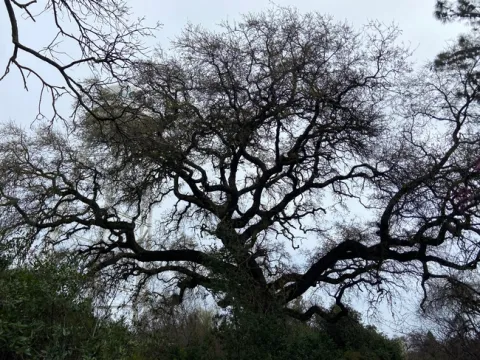I often rambleYolo County preserves. Since being in Master Gardener training, I have become a better observer, noticing the startling seasonal changes. I have also become a better inquirer, asking questions about what I see.

My most recent query has been about the valley oak, the lead plant in our Yolo County ecosystem. Why, I wonder, do these majestic trees spread their arms so wide and have such baroque, curvy branches, when many other trees go straight up?
To answer this question, I reached out to Michael Jones, PhD, a scientist at UC Oaks. He replied: “My thoughts are that as one of the fastest growing native oak species, each branch is in a race to reach as much light as possible to maximize photosynthetic capacity. Since oaks with lots of space like to grow out, as well as up, I imagine the branches are trying to extend faster than their neighbors and as they reach something that impedes their pathway (like other branches), they redirect growth around that object…They are (also) dealing with gravity and as those long lateral and heavy branches keep extending out, we might be seeing some of the curves and curls as changes in direction to account for the effects of gravity.”
We are lucky to have many oak preserves in the Davis area. Hope to see you there!
UC Davis Arboretum and Public Gardens- This beautiful, curated garden is entered at the east through the Gateway Garden at First and D Streets or at the west at the Peter J. Shields Oak Grove, 1 Garrod Drive.
Putah Creek Reserve: This 640-acre natural riparian ecosystem borders Putah Creek south of UCD. One access point is the Fire Ring Picnic Grounds. Take Hutchison Drive to Hopkins Road, then turn south until the road dead ends at Putah Creek.
UC Oaks: https://oaks.cnr.berkeley.edu

